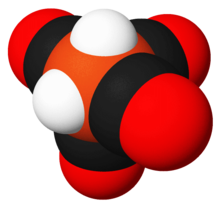Iron tetracarbonyl dihydride
 | |
 | |
| Names | |
|---|---|
| Preferred IUPAC name
Tetracarbonyldihydridoiron(II)[citation needed] | |
| Other names
Iron tetracarbonyl dihydride, tetracarbonyldihydroiron
| |
| Identifiers | |
3D model (JSmol)
|
|
| ChemSpider | |
PubChem CID
|
|
| |
| |
| Properties | |
| FeC 4H 2O 4 | |
| Molar mass | 169.901 g mol−1 |
| Appearance | Liquid (at -20 °C) |
| Melting point | −70 °C (−94 °F; 203 K) |
| Boiling point | −20 °C (−4 °F; 253 K) (decomposes) |
Except where otherwise noted, data are given for materials in their standard state (at 25 °C [77 °F], 100 kPa).
| |
Iron tetracarbonyl dihydride is the organometallic compound with the formula H2Fe(CO)4. This compound was the first transition metal hydride discovered. The complex is stable at low temperatures but decomposes rapidly at temperatures above –20 °C.[1]
Preparation
[edit]Iron tetracarbonyl dihydride was first produced by Hieber and Leutert from iron pentacarbonyl, which is first converted to HFe(CO)−
4:[2][3]
- Fe(CO)5 + 2 OH− → HFe(CO)−
4 + HCO−
3 - HFe(CO)−
4 + H+ → H2Fe(CO)4
Since the compound is thermally labile and sensitive to light, ideal conditions in 1930's Munich called for winter nights. The early method was called the "polar night synthesis."
As recommended by Hieber and Leutert, the compound can be purified by trap-to-trap distillation.[1][4]
Structure and properties
[edit]In iron tetracarbonyl hydride the Fe(CO)4 group has C2v molecular symmetry with a geometry intermediate between octahedral and tetrahedral. Viewed as an octahedral complex, the hydride ligands are cis. Viewed as a tetrahedral Fe(CO)4 complex, the hydrides occupy adjacent faces of the tetrahedron.[5] Although the structure of tetracarbonyliron with the hydrogen atoms bound as a single H2 ligand has been proposed as an intermediate in some rearrangement reactions,[6] the stable state for the compound has the two atoms as independent ligands.[7]
Reactions
[edit]Iron tetracarbonyl dihydride undergoes rapid ligand substitutions by phosphorus ligands:
- H2Fe(CO)4 + PPh3 → H2Fe(CO)3PPh3
The substitution mechanism is proposed to entail transient formation of a 16e− formyl intermediate.[8]
H2Fe(CO)4 has pK1 of 6.8 and pK2 of 15.[9] The monoanion [HFe(CO)4]− has more extensive reaction chemistry because it is more stable than the dihydride.[10][11] The monoanion is an intermediate in the homogeneous iron-carbonyl-catalyzed water-gas shift reaction (WGSR). The slow step in the WGSR is the proton transfer from water to the iron hydride anion.[12]
- HFe(CO)−
4 + H2O → H2Fe(CO)4 + OH−
See also
[edit]Further reading
[edit]- Tsai, J.-C.; Khan, M.A.; Nicholas, K.M. (1991). "Reduction of Coordinated Carbon Dioxide by Transition-Metal Hydrides". Organometallics. 10: 29–30. doi:10.1021/om00047a016.
- Farmery, K.; Kilner, M. (1970). "Substitution reactions of dihydridotetracarbonyliron". Journal of the Chemical Society A: 634. doi:10.1039/J19700000634.
References
[edit]- ^ a b Blanchard, Arthur A.; Coleman, George W. (1946). "Iron Tetracarbonyl Dihydride". Inorganic Syntheses. Vol. 2. pp. 243–244. doi:10.1002/9780470132333.ch77. ISBN 9780470132333.
- ^ Hieber, W.; Leutert, F. (1931). "Zur Kenntnis des koordinative gebundene Kohlenoxyds: Bildung von Eisencarbonylwasserstoff". Naturwissenschaften. 19 (17): 360. Bibcode:1931NW.....19..360H. doi:10.1007/BF01522286. S2CID 791569.
- ^ Rittmeyer, P.; Wietelmann, U. (2006). "Hydrides". Ullmann's Encyclopedia of Industrial Chemistry. Weinheim: Wiley-VCH. doi:10.1002/14356007.a13_199. ISBN 978-3-527-30673-2.
- ^ Vancea, L.; Graham, W.A.G. (1977). "Stereochemically Nonrigid Six-Coordinate Metal Carbonyl Complexes". J. Organomet. Chem. 134 (2): 219. doi:10.1016/S0022-328X(00)81421-7.
- ^ McNeill, E. A.; Scholer, F. R. (1977). "Molecular structure of the gaseous metal carbonyl hydrides of manganese, iron, and cobalt". J. Am. Chem. Soc. 99 (19): 6243. doi:10.1021/ja00461a011.
- ^ Soubra, C.; Oishi, Y.; Albright, T. A.; Fujimoto, H. (2001). "Intramolecular Rearrangements in Six-Coordinate Ruthenium and Iron Dihydrides". Inorg. Chem. 40 (4): 620–627. doi:10.1021/ic0006089. PMID 11225102.
- ^ Drouin, B. J.; Kukolich, S. G. (1998). "Molecular Structure of Tetracarbonyldihydroiron: Microwave Measurements and Density Functional Theory Calculations". J. Am. Chem. Soc. 120 (27): 6774–6780. doi:10.1021/ja9741584.
- ^ Pearson, R. G.; Walker, H. W.; Mauermann, H.; Ford, P.C. (1981). "Hydrogen migration mechanism for ligand substitution reactions in metal carbonyl hydrides". Inorg. Chem. 20 (8): 2741. doi:10.1021/ic50222a078.
- ^ Walker, H.W.; Kresge, C.T.; Ford, P.C.; Pearson, R. G. (1979). "Rates of Deprotonation and pKa Values of Transition Metal Carbonyl Hydrides". J. Am. Chem. Soc. 101 (24): 7428. doi:10.1021/ja00518a061.
- ^ Brunet, J.-J.; Chauvin, R.; Diallo, O.; Kindela, F.; Leglaye, P.; Neibecker, D., "Coordination chemistry of mononuclear iron carbonyl complexes", Coordination Chemistry Reviews 1998, 178-180, 331-352. doi:10.1016/S0010-8545(98)00075-7
- ^ Brunet, J.J. (1990). "Tetracarbonylhydridoferrates, MHFe(CO)4: Versatile tools in Organic Synthesis and Catalysis". Chem. Rev. 90 (6): 1041–1059. doi:10.1021/cr00104a006.
- ^ Crabtree, R.H. Mingos D.M.P. 2007. Comprehensive Organometallic Chemistry III From Fundamentals to Applications. Elsevier Ltd.
